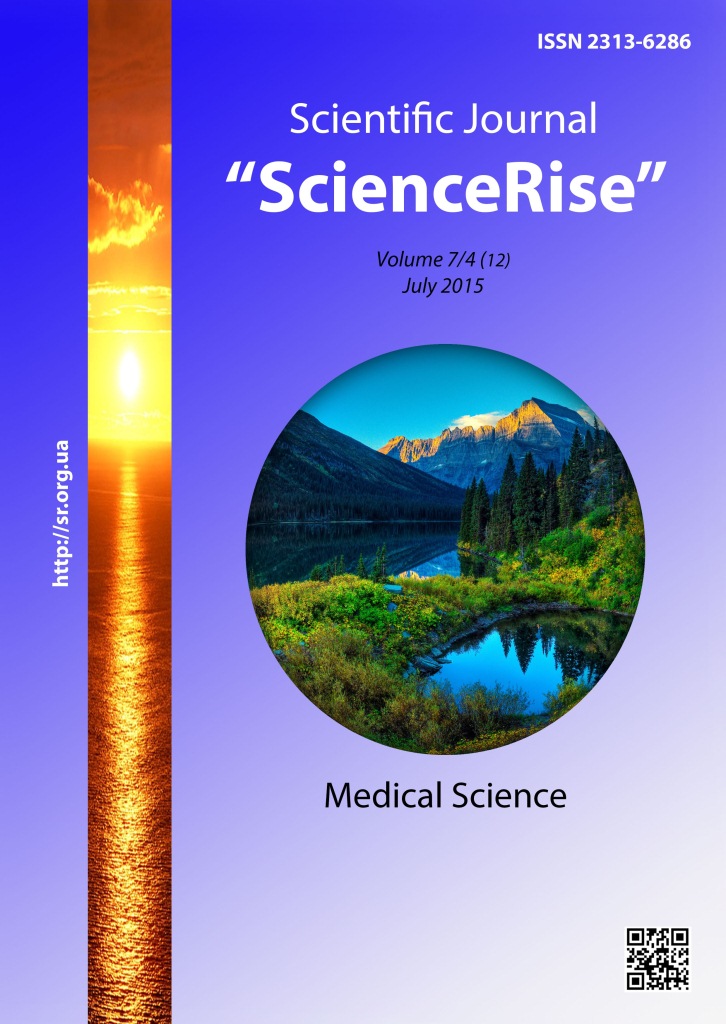Comparative study of clindamycin concentration in the cerebrospinal fluid after intravenous and intrathecal administration in patients with toxoplasmic meningoencephalitis
DOI:
https://doi.org/10.15587/2313-8416.2015.47265Keywords:
toxoplasmic meningoencephalitis, clindamycin, intrathecal administration, cerebrospinal fluid (CSF), concentration, safety, efficiency.Abstract
Aim of the work: to study the difference of clindamycin concentration in CSF at the intravenous and combined (intrathecal + intravenous) ways of administration of preparation.
Materials and methods: study was carried out at the treatment of 11 HIV-positive patients 27-63 years old (men and women) with toxoplasmic meningoencephalitises.
There was measured the clindamycin concentration in CSF of every patient after intravenous and combined (intrathecal + intravenous) ways of administration of preparation. The determinations of concentration were done by the way of the reverse-phase high-performance liquid chromatography (HPLC) with ultraviolet (UV) detection. Statistic processing of the received data was carried out using the Wilcoxon criterion.
Results of research. There was received the statistically significant increase of clindamycin concentration in CSF of patients in a day after combined (intrathecal + intravenous) administration of preparation comparing with an intravenous administration.
Conclusions. 1. Intrathecal administration of 150 mg. of clindamycin with 8 mg. of dexamethasone is safe.
2. Intrathecal administration of 150 mg. of clindamycin with 8 mg. of dexamethasone in combination with an intravenous administration of preparation leads to statistically significant increase of clindamycin concentration in CSF at least during a day after injection.
3. Intrathecal administration of clindamycin with dexamethasone in offered doses can be recommended for treatment of meningoencephalitises that caused by microorganisms susceptible to clindamycin.
4. If the therapy of toxoplasmic meningoencephalitis was started with an intravenous prescription of clindamycin it is recommended an additional treatment with an intrathecal administration of clindamycin with dexamethasone in offered doses to increase efficiency by creating an effective concentration of preparation in the nidus of infection.
5. Intrathecal methods of therapy must be used by the specialists of the respective qualification.
References
Nedz'ved', M. K., Rogov, Ju. I., Metel'skaja, M. A., Grishenkova, L. N., Ivanova, M. A., Bohan, I. V. (2012). Toksoplazmoznyj meningojencefalit u bol'nyh VICh/SPID (klinikomorfologicheskij analiz). Zdravoohranenie, 2, 4–7.
Gryzhak, I. G., Dykyj, B. M., Kondryn, O. Je., Ostjak, R. S., Procyk, A. L. (2012). Algorytm diagnostyky toksoplazmozu u VIL-infikovanyh zhinok reproduktyvnogo viku ta likuval'na taktyka. Profilaktychna medycyna, 1, 27–31.
Bartlett, D., Gallant, D. (2003). Klinicheskij podhod k lecheniju VICh-infekcii. Baltimore, 394.
DALACYN C™ : instrukcija, zastosuvannja preparatu. – Available at: www/URL: http://mozdocs.kiev.ua/likiview.php?id=6537
Nau, R., Sorgel, F., Eiffert, H. (2010). Penetration of Drugs through the Blood-Cerebrospinal Fluid/Blood-Brain Barrier for Treatment of Central Nervous System Infections. Clinical Microbiology Reviews, 23 (4), 858–883. doi: 10.1128/CMR.00007-10
Vashukov, S. A., Poljashov, A. S., Porohin, V. G. (2002). Lechenie i profilaktika posttravmaticheskih meningitov. Tez. dokl. YIII Vseros. s’ezda anesteziol.-reanimatol. Omsk, 96.
Kubrakov, K. M., Kosinec, A. N., Akulenok, A. V. (2008). Intratekal'noe vvedenie antibakterial'nyh preparatov u nejrohirurgicheskih bol'nyh s meningojencefalitami. Novosti hirurgii, 16 (4), 86–93.
Carenko, S. V. (2006). Nejroreanimatologija. Intensivnaja terapija cherepno-mozgovoj travmy. Moscow : Medicina, 352.
Berning, S. E., Cherry, T. A., Iseman, M. D. (2001). Novel Treatment of Meningitis Caused by Multidrug-Resistant Mycobacterium tuberculosis with Intrathecal Levofloxacin and Amikacin: Case Report. Clinical Infectious Diseases, 32 (4), 643–646. 10.1086/318698
Borshhov, S. P., Fіl'chakov, І. V., Sіnіcin, P. V., Seredins'ka. N. M. (2012). Eksperimental'ne doslіdzhennja bezpechnostі іntratekal'nogo zastosuvannja klіndamіcinu. Profіlaktichna medicina, 3–4, 76–81.
Downloads
Published
Issue
Section
License
Copyright (c) 2015 Сергей Петрович Борщев

This work is licensed under a Creative Commons Attribution 4.0 International License.
Our journal abides by the Creative Commons CC BY copyright rights and permissions for open access journals.
Authors, who are published in this journal, agree to the following conditions:
1. The authors reserve the right to authorship of the work and pass the first publication right of this work to the journal under the terms of a Creative Commons CC BY, which allows others to freely distribute the published research with the obligatory reference to the authors of the original work and the first publication of the work in this journal.
2. The authors have the right to conclude separate supplement agreements that relate to non-exclusive work distribution in the form in which it has been published by the journal (for example, to upload the work to the online storage of the journal or publish it as part of a monograph), provided that the reference to the first publication of the work in this journal is included.

